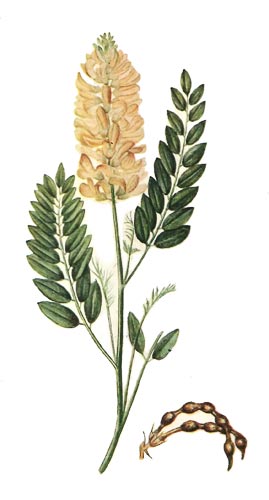Weeds
Pseudosophora alopecuroides I. - Sophora Root
Systematic position.
Family Fabaceae Lindl., genus Pseudosophora (DC.)SweetSynonyms.
Vexibia alopecuroides (L.) Yakovl., Goebelia alopecuroides (L.) BoissBiological group.
Perennial weed forming rootstocks.Morphology and biology.
Plant is 50-100 cm in height with deep penetrating roots - thick tap roots reach down 3m and more, root neck is strongly elongated and penetrates into the soil more than 20 cm, extensively producing horizontal long roots with numerous buds which give rise to over-ground shoots. Stem is branched, finely pubescent, usually in upper part profusely foliaceous. Leaves are imparipinnately compound, with 5-12 pairs of oval or oblong leaflets, covered with small accumbent white hairs from both sides. Flowers are white or slightly yellowish-cream-colored, aggregated in thick terminal multi-flowered inflorescences. Calyx is widely bell-shaped, densely and finely pubescent, with short spreading triangular teeth which are equal to 1/4-1/5 of calyx tube in length. Standard is obovoid, narrowed downwards, equal to wings and keel or longer; wings are in small transverse folds along one edge and rugous, keel is sharp at top. Fruits are bead-like pods, usually curved, indehiscent, with sparsely arranged seeds and long narrowed seedless (empty) parts, covered with small accumbent hairs, numerous, aggregated at the stem top, sometimes with underdeveloped seeds. Seeds are globular-ovate, yellowish and light brown, sometimes darker, glabrous, slightly lustrous, with roundish raphe. This plant flowers from April to June, bears fruits in June-August. Each stem produces up to 60-80 fruits, containing 600-800 seeds. Seeds with intact testa germinate slowly and keep germination capacity for a long time. Optimum temperature for seed germination is 20-25°C. The most important is vegetative reproduction - by fragments of horizontal roots and underground stem parts, which starts in spring under the soil temperature 10-12°C and strenuously goes under the temperature 15-17°C and higher.Distribution.
Asia Minor, Afghanistan, Tibet. Within the former Soviet Union - Central Asia, Kazakhstan, southern shore of Crimea, the Caucasus.Ecology.
This plant grows in wet places - along banks of rivers and irrigation canals, less often in steppes and deserts (under a high level of subterranean waters), sometimes it develops dense but small in area thickets, often in mixture with other plants. It also occurs near roads, in waste and lea lands, gardens, in plains and piedmonts, typically preferring solonchak soils.Economic significance.
Weed of cotton and grain crops in irrigated lands, weed of grain crops in dry-farming lands. P. alopecuroides propagates steadily under low level of agronomical control. This is a poisonous plant, it contains alkaloids. Control measures: deep soil treatment in dry period, fine crushing of root fragments and their deep embedding into soil in early spring or late autumn.Reference citations:
Keller, B.A., ed. 1934. Weed plants of the USSR. V. 3. Leningrad: AN SSSR. 448 p. (in Russian).Komarov, V.L., ed. 1945. Flora of the USSR. V.11. Moscow-Leningrad: AN SSSR. 432 p. (in Russian).
Nikitin, V.V. 1983. Weed plants of the USSR flora. Leningrad: Nauka. 454 p. (in Russian).
Pak K.I. 1959. To the question of control measures against Sophora alopecuroides L. In: Parshenkov, S., Kirichek, F., eds. Proceedings of Kazakh Research Institute of Farming named after V.P.Vilyams. Alma-Ata: Kazakh State Publishing House. p.230-43. (in Russian).
Roskov, Yu. 2005. Sophora alopecuroides. Legume Web - International Legume Database and Information Service (ILDIS), version 10.01. UK, University of Reading, School of Plant Sciences:
http://www.ildis.org/LegumeWeb?version~10.01&LegumeWeb&two~6266&genus~Sophora&species~alopecuroides#1


